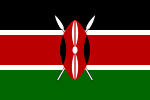
Back Самбуру Byelorussian Samburové Czech Samburu German Samburuoj Esperanto Samburud Estonian Samburu (peuple) French סמבורו (קבוצה אתנית) HE Szamburuk Hungarian Samburu ID Samburu (popolo) Italian
This article needs additional citations for verification. (March 2016) |
 | |
| Total population | |
|---|---|
| 333,471[1] | |
| Regions with significant populations | |
| Samburu county (Kenya) | |
| Languages | |
| Samburu, Swahili, English | |
| Religion | |
| Christianity, Traditional beliefs | |
| Related ethnic groups | |
| Other Nilotic peoples |
| Part of a series on the |
| Culture of Kenya |
|---|
 |
| Cuisine |
The Samburu are a Nilotic people of north-central Kenya. Traditionally, they are semi-nomadic pastoralists who primarily herd cattle but also keep sheep, goats and camels. They refer to themselves as Lokop or Loikop, a term with varied interpretations among the Samburu. Some believe it means "owners of the land" ("lo" meaning ownership and "nkop" meaning land) while others have different interpretations.
The Samburu speak the Samburu dialect of the Maa language, a Nilotic language which is also spoken by 22 other sub tribes of the Maa community commonly known as the Maasai. Some [who?] suggest that the Samburu are a distinct tribe separate from the Maasai, a view that [neutrality is disputed] some Samburu people accept today.[citation needed]
Samburu National Reserve is one of the well known wildlife conservation areas in Kenya. Within the Maa community of Kenya and Tanzania, the Samburu sub-tribe is the third largest, following the Kisonko (Isikirari) of Tanzania and Purko of Kenya and Tanzania.
- ^ "2019 Kenya Population and Housing Census Volume IV: Distribution of Population by Socio-Economic Characteristics". Kenya National Bureau of Statistics. Retrieved 24 March 2020.